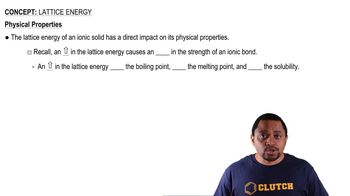Consider the lattice energies of the following Group 2A compounds: BeH2, 3205 kJ/mol; MgH2, 2791 kJ/mol; CaH2, 2410 kJ/mol; SrH2, 2250 kJ/mol; BaH2, 2121 kJ/mol. (a) What is the oxidation number of H in these compounds?
Ch.8 - Basic Concepts of Chemical Bonding

Brown14th EditionChemistry: The Central ScienceISBN: 9780134414232Not the one you use?Change textbook
Chapter 8, Problem 79c
Consider the lattice energies of the following Group 2A compounds: BeH2, 3205 kJ/mol; MgH2, 2791 kJ/mol; CaH2, 2410 kJ/mol; SrH2, 2250 kJ/mol; BaH2, 2121 kJ/mol. (c) Consider BeH2. Does it require 3205 kJ of energy to break one mole of the solid into its ions, or does breaking up one mole of solid into its ions release 3205 kJ of energy?
 Verified step by step guidance
Verified step by step guidance1
Understand the concept of lattice energy: Lattice energy is the energy required to separate one mole of an ionic solid into its gaseous ions. It is always a positive value because energy is required to overcome the electrostatic forces holding the ions together in the solid.
Identify the given lattice energy for BeH2: The problem states that the lattice energy for BeH2 is 3205 kJ/mol.
Interpret the meaning of the lattice energy value: Since lattice energy is defined as the energy required to break the solid into its ions, a value of 3205 kJ/mol means that 3205 kJ of energy is needed to break one mole of BeH2 solid into its gaseous ions.
Clarify the direction of energy flow: The positive sign of the lattice energy indicates that energy is absorbed in the process of breaking the solid into ions, not released.
Conclude the interpretation: Therefore, it requires 3205 kJ of energy to break one mole of BeH2 solid into its ions, rather than releasing 3205 kJ of energy.

Verified video answer for a similar problem:
This video solution was recommended by our tutors as helpful for the problem above.
Video duration:
2mWas this helpful?
Key Concepts
Here are the essential concepts you must grasp in order to answer the question correctly.
Lattice Energy
Lattice energy is the amount of energy released when one mole of an ionic solid forms from its gaseous ions. It is also the energy required to break the ionic solid into its constituent ions. A higher lattice energy indicates a stronger ionic bond, which typically results from smaller ions or higher charges.
Recommended video:
Guided course

Lattice Energy
Endothermic vs. Exothermic Processes
An endothermic process absorbs energy from the surroundings, while an exothermic process releases energy. In the context of lattice energy, breaking a solid into ions is an endothermic process, requiring energy input, whereas the formation of the solid from ions is exothermic, releasing energy.
Recommended video:
Guided course

Endothermic & Exothermic Reactions Example 2
Thermodynamic Sign Convention
In thermodynamics, the sign convention for energy changes is crucial. A positive value indicates that energy is absorbed (endothermic), while a negative value indicates that energy is released (exothermic). Understanding this convention helps clarify whether the given lattice energy value corresponds to energy required to break the solid or energy released during its formation.
Recommended video:
Guided course

First Law of Thermodynamics
Related Practice
Textbook Question
Textbook Question
Consider the lattice energies of the following Group 2A compounds: BeH2, 3205 kJ/mol; MgH2, 2791 kJ/mol; CaH2, 2410 kJ/mol; SrH2, 2250 kJ/mol; BaH2, 2121 kJ/mol. (d) The lattice energy of ZnH2 is 2870 kJ/mol. Considering the trend in lattice enthalpies in the Group 2 compounds, predict which Group 2 element is most similar in ionic radius to the Zn2+ ion.
Textbook Question
The ionic compound CaO crystallizes with the same structure as sodium chloride (Figure 8.3). (a) In this structure, how many O2- are in contact with each Ca2+ ion (Hint: Remember the pattern of ions shown in Figure 8.3 repeats over and over again in all three directions.)
